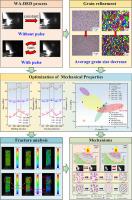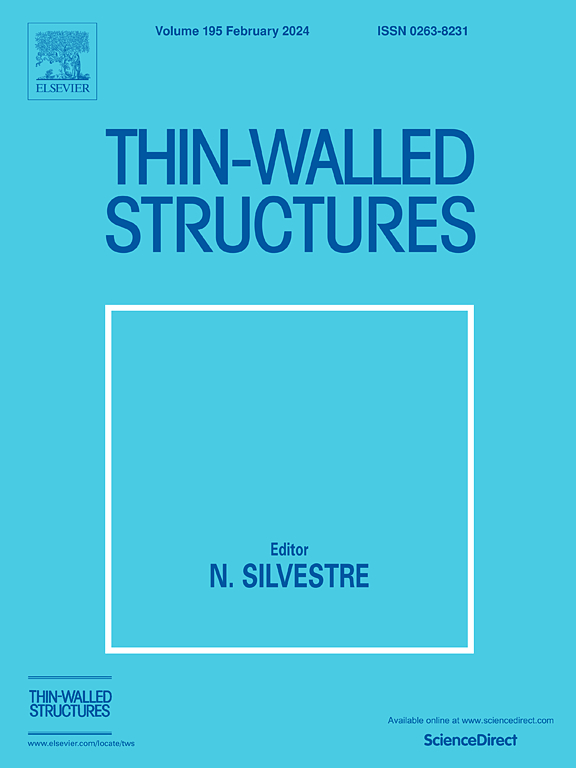利用脉冲电流氩弧焊线-弧定向能沉积技术制造的 Mg-Nd-Zn-Zr 合金的微观结构和力学性能
IF 6.6
1区 工程技术
Q1 ENGINEERING, CIVIL
引用次数: 0
摘要
本研究采用基于钨惰性气体(TIG)的线弧定向能沉积(WA-DED)技术,以不同的脉冲电流制备了 Mg-Nd-Zn-Zr 合金薄壁试样。观察了不同脉冲电流频率下的电弧特性。系统分析和评估了原沉积 (AD)、5 Hz、10 Hz、15 Hz 和 20 Hz 试样的微观结构和机械性能。在 WA-DED 制造的 Mg-Nd-Zn-Zr 合金薄壁试样中发现了具有随机晶粒取向的均匀等轴晶粒和晶间网络 Mg-Nd-Zn 共晶。没有发现明显的空隙。通过调节脉冲电流频率,微观结构得到了调节,力学性能也得到了改善。10 Hz 试样具有最佳微观结构,平均晶粒大小为 10.35 μm。同时,10 赫兹试样具有优异的强度-电导率协同性和各向同性,这得益于精细的等轴晶粒。10 Hz 试样的平均显微硬度为 68.51 HV0.2,建筑方向和行进方向的极限抗拉强度分别为 223 兆帕和 229.7 兆帕,建筑方向和行进方向的屈服强度分别为 138.3 兆帕和 145.3 兆帕。值得注意的是,10 Hz 试样在建筑方向和行进方向的伸长率分别为 16.8 % 和 17.4 %。观察了 AD 和 10 Hz 试样在建筑和行进方向上的局部应变演变和断裂面。揭示了晶粒细化和力学性能改善的机制。本文章由计算机程序翻译,如有差异,请以英文原文为准。

Microstructure and mechanical properties of Mg-Nd-Zn-Zr alloy fabricated by TIG-based wire – Arc directed energy deposition with pulsed current
In this study, the Mg-Nd-Zn-Zr alloy thin-wall specimens were prepared by tungsten inert gas (TIG) based wire-arc directed energy deposition (WA-DED) with different pulsed currents. The arc characteristics of different pulsed current frequents were observed. The microstructures, and mechanical properties of as-deposited (AD), 5 Hz, 10 Hz, 15 Hz, and 20 Hz specimens were systematically analyzed and evaluated. The uniformly equiaxed crystals with random grain orientations and intergranular network Mg-Nd-Zn eutectics were found in the WA-DED fabricated Mg-Nd-Zn-Zr alloy thin-wall specimens. No significant voids were found. The microstructures were regulated, and the mechanical properties were improved by adjusting the pulsed current frequency. The 10 Hz specimen had the optimal microstructure with an average grain size of 10.35 μm. Concurrently, the 10 Hz specimen exhibits excellent strength-ductility synergy and isotropic, benefiting from the finely equiaxed crystals. The average microhardness of the 10 Hz specimen was 68.51 HV0.2, and the ultimate tensile strengths in the building and traveling directions were 223 MPa and 229.7 MPa, respectively, and the yield strengths in the building and traveling directions were 138.3 MPa and 145.3 MPa, respectively. Notably, the elongations in the building and traveling directions of the 10 Hz specimen were 16.8 % and 17.4 %, respectively. The local strain evolution and fracture surfaces of AD and 10 Hz specimens in the building and traveling directions were observed. The mechanisms of grain refinement and mechanical properties improvement were revealed.
求助全文
通过发布文献求助,成功后即可免费获取论文全文。
去求助
来源期刊

Thin-Walled Structures
工程技术-工程:土木
CiteScore
9.60
自引率
20.30%
发文量
801
审稿时长
66 days
期刊介绍:
Thin-walled structures comprises an important and growing proportion of engineering construction with areas of application becoming increasingly diverse, ranging from aircraft, bridges, ships and oil rigs to storage vessels, industrial buildings and warehouses.
Many factors, including cost and weight economy, new materials and processes and the growth of powerful methods of analysis have contributed to this growth, and led to the need for a journal which concentrates specifically on structures in which problems arise due to the thinness of the walls. This field includes cold– formed sections, plate and shell structures, reinforced plastics structures and aluminium structures, and is of importance in many branches of engineering.
The primary criterion for consideration of papers in Thin–Walled Structures is that they must be concerned with thin–walled structures or the basic problems inherent in thin–walled structures. Provided this criterion is satisfied no restriction is placed on the type of construction, material or field of application. Papers on theory, experiment, design, etc., are published and it is expected that many papers will contain aspects of all three.
 求助内容:
求助内容: 应助结果提醒方式:
应助结果提醒方式:


